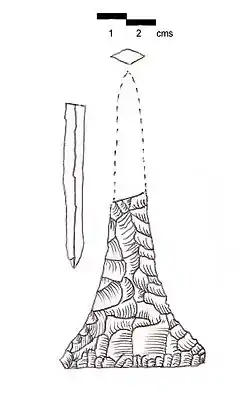Minet ed Dhalia point
A Minet ed Dhalia point or stylet is an archaeological term for an elongated, isosceles triangle made with pressure flaking on both faces of a piece of flint. They are predominantly found at sites in Lebanon (ancient Canaan).[1] They are the type tool of the Énéolithique Ancien (Ancient Chalcolithic), named after the archaeological site of Minet ed Dhalia in Ras Beirut. The stylets range from 2 inches (5.1 cm) to 8 inches (20 cm) in length. They were first observed by Dawson in 1884 and later by Godefroy Zumoffen in 1910 and called "stylets" by Raoul Describes.[2] The exact use of Minet ed Dhalia points is uncertain although the shape bears certain similarities to metal fleshing tools used in the area in modern times.[1]

Minet ed Dhalia point. Also called a "stylet". Discovered at Shemlan. White patinated flint.
References
- Lorraine Copeland; P. Wescombe (1965). Inventory of Stone-Age sites in Lebanon, p. 49 and Figure XVI, p. 162. Imprimerie Catholique. Retrieved 21 July 2011.
- Zumoffen, Godefroy., Le Néolithiqueen Phénicie, Anthropos, Volume 5, Plate V, p. 150, 1910.
This article is issued from Wikipedia. The text is licensed under Creative Commons - Attribution - Sharealike. Additional terms may apply for the media files.
